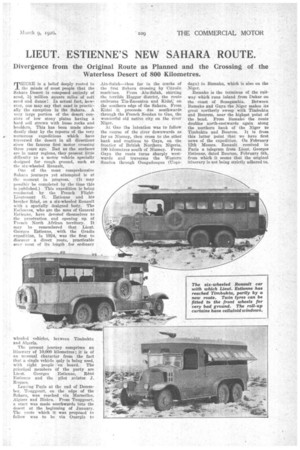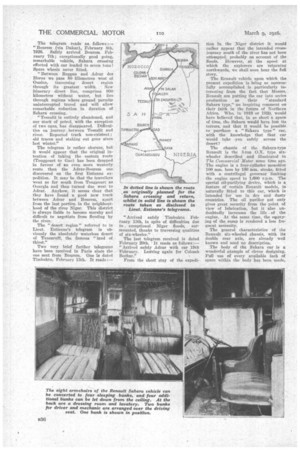LIEUT. ESTIENNE'S NEW SAHARA ROUTE.
Page 19

Page 20

Page 21

If you've noticed an error in this article please click here to report it so we can fix it.
Divergence from the Original Route as Planned and the Crossing of the Waterless Desert of 800 Kilometres.
THERE is a belief deeply rooted in the minds of most people that the Sahara Desert is composed entirely of sand, million square milesof soft sand and dunes! In actual fact, however, one may say that sand is practically the exception in the Sahara. A Very large portion of the desert consists of low stony plains having a hard soil strewn with loose rocks and boulders. This has been made abundantly clear by the reports of the very numerous expeditions which have traversed the desert in all directions since the famous first motor crossing three years ago. Bad as the surfaces are in many regions, they present little difficulty to a motor vehicle specially designed for rough ground, such as the six-wheeled Renault.
One of the most Comprehensive Sahara journeys yet attempted is at the moment in progress. (It may possihly be completed by the time this is mildished.) This expedition is being conducted by the French FlightLienten ant G. Estienne and his brother Ren4, on a six-wheeled Renault with a specially designed body. The Estienne, who are the sons of General Estienne, have devoted themselves to the penetration_ and opening up of French North Afriban territory. It may be remembered that Lieut. Georges Estienne. with the gradis expedition, in 1924, was the first to discover a direct route, practicable over most of its length for ordinary
wheeled vehicles, between Timbuktu and Algeria.
The present journey comprises an itinerary of 10,000 kilometres; it is of an unusual character from the fact that a single vehicle 1:}nIy is being used, with eight people on board. The principal members of the party are Lieut. Georges Estienne, Rnd Estienne and the pilot aviator J. • Rogues.
Leaving' Parisat the end of December, Touggourt, on the edge of the Sahara, was reached via Marseilles, Algiers and Biskra. From Touggourt, a start was made southwards into the desert at the beginning of January. The route which it was propasedto follow was to be via Ouargla to
Ain-Salah—thus far in the tracks of the first Sahara crossing by eitroiin machines. From Ain-Salah, skirting the terrible lloggar district, the route. embraces Tin-Zaouaten and Kidal; on the southern edge of the Sahara. From Kidal -it proceeds due southwards through the French Soudan to Gao, the wonderful old native city on the river Niger.
At Gao the intention was to. follow the course of the river downwards as far as Niamey, then cross to the other bank and continue to Gaya, on the frontier of British Northern Nigeria, 100 kilometres south of Niamey. From Gaya the route turns sharply westwards and traverses the Western Soudan through Ouagadougou (Uoga-, dagu) to Bamako, which is also on the Niger.
Bamako is the terminus of the railway which runs inland from Dakar on the coast of Senegambia. Between Bamako and Gaya the Niger makes its great northerly sweep with Timbuktu and Bourem, near the highest point of the bend. From Bamako the route doubles north-eastwards again along the northern bank of the Niger to Timbuktu and Bourem. It is from this latter point that we have first news of the expedition. On February 12th Messrs. Renault received in Paris a telegram from Lieut. Georges Estienne, dated Bourem, February 8th, from which it seems that the original itinerary is not being strictly adhered to. The telegram reads as follows: "Bourem .(via Dakar), February 8th, 1926. Safely arrived Bourem February 7th ; exceptionally good going, remarkable vehicle, Sahara crossing effected with car loaded to seven tons! Spare wheels never fitted.
"Between Reggan and Adrar des Iforas we pass SO kilometres west of Oualen, traversing desert region through its • greatest width. New itinerary direct line, comprises 800 kilometres Without water, but lies through regions where ground permits uninterrupted travel and will allow remarkable reduction in duration of Sahara crossing.
" Tessalit is entirely abandoned, and our stock of petrol, with the exception of two cans, has disappeared. Difficulties on journey ,between Tessalit and river. Reported track non-existent; eld traees and staking out gone since last winter."
The telegram is rather obscure, but it would appear that the original intention of taking the eastern route (Touggourt to Gao) has been dropped in favour of an even more westerly route, than the Adrar-Bonrem one discovered on the first Estienne expedition. It may be that the travellers went as far south from Touggourt as Ouargla and then turned due west to Adrar. Anyhow, it. seems clear that they have found a good new track between Adrar and Bourern, apart from the last portion in the neighbourhood of the river Niger. This district is always liable to become marshy and difficult to negotiete from flooding by the river.
The " desert region " referred to in Lieut. Estienne'e telegram is obviously the absolutely waterless desert a Tanezruffi the famous " land of thirst."
Two very brief further telegrams have been received in Paris since the one sent from BOurem. One is dated Timbuktu, February 13th. It reads :— "Arrived safely Timbuktu February 13th, in spite of difficulties due to. exceptional Niger floods, surmounted, thanks to traversing qualities of six-wheeler."
The last telegram received is dated February 20th. It reads as follows:— " Arrived safely Adrar with car 19th February. Leaving again for Colomb Bechar,"
From the short stay of the expedi
tion in the Niger district it would rather appear that the intended crossjourney south of the river has not been attempted, probably on account of the floods. However, at the speed at which the explorers are retjuning northwards, we shall soon hear the full story, The Renault vehicle upon which the present expedition is being so successfully accomplished is particularly interesting from the fact that Messrs. Renault are putting the ear into series production as their " standard Sahara type," an inspiring comment on their faith in the future of Northern Africa. Who, in 1919 or 1920, would have believed that, in so short a space of time, the Sahara would have lost its terrors, and that it would be possible to purehase a "Sahara type" ear, with the knowledge that that ear would take -you safely across the desert?
The ,chassis of the Sahara-type Renault is the 3-ton O.X. type sixwheeler described and illustrated in Tile Commercial Motor some time ago. The engine is a four-cylinder monobloc 100 mm. bore by 160 mm. stroke, fitted with a centrifugal governor limiting the engine speed to 1,600 r.p.m. rhe special oil-purifying device, which is a. feature of certain Renault models, le naturally fitted to this car, which is intended for use in dry and dusty countries. The oil purifier not only gives great security from the point of view of lubrication, but it also undoubtedly increases the life of the engine. At the same time, the empty. ing of the sump is rendered a less fre event necessity.
The general characteristics of the Renault six-wheeled chassis, with its double rear axle, are already well known and need no description.
The body of the Sahara ear is a wonderful example of clever designing. Full use of every available inch of space within the body has been made, and yet an impression of roominess is given. The car is not merely an eightseater coach ; it is an eight-sleeper. There are eight most comfortable interior seats arranged with a central gangway between them. A. mechanic Is accommodated beside the driver, go that the total complement of the coach Is ten persons. At night the seats are folded and replaced by comfortable bunks. At the rear a lavatory and w.e. are arranged in two small separate com partments.
The special spare wheels, which can be used in case of necessity, such as on very bad ground, to give dual tyres, are carried externally on the right and left of the body. Two ordinary spare wheels are carried at the rear. An exceptionally capacious fuel tank is fitted under the scuttle containing about 120 litres. In this tank is a Weymann vacuum-feed apparatus which draws petrol from another large tank at the rear of the chassis containing about 300 litres. The total fuel-carrying capacity of the car is thus nearly 420 litres. Allowing for the very high fuel consumption of from 35 to 40 litres per 100 kilometres—a consumption, it may be mentioned, which has never been reached on the vehicle's trials— we have an active radius of at least 1,000 kilometres for the coach without replenishing tanks.
The sides of the body are open undee ordinary circumstances, in view of the climates for which it is intended ; they can be closed when required, however, by means of canvas panels with celluloid windows. As hostile tribesmen are sometimes, although not often, to be met with in the Sahara, it machine-gun is mounted on the roof and reached through a trapdoor.
The design of the body is the work of M. Convert, who is certainly deserving of praise for the minute care and attention which have obviously. been given to every tiny detail.
The "Sahara type" is a worthy representative of Renault thoroughness in all things, and maintains the traditions of its smaller predecessors, the famous 10 h.p. Renault sixwheelers. Amongst outstanding exploits with the smaller Renault sixwheeler may be cited the extraordinary lone-handed expedition of Captain Delingette from Algeria to the Cape.




























